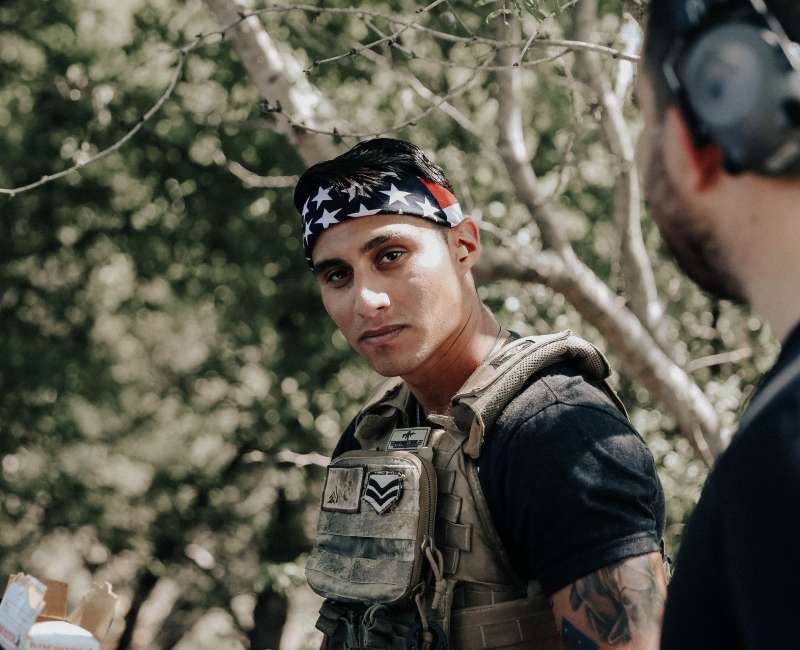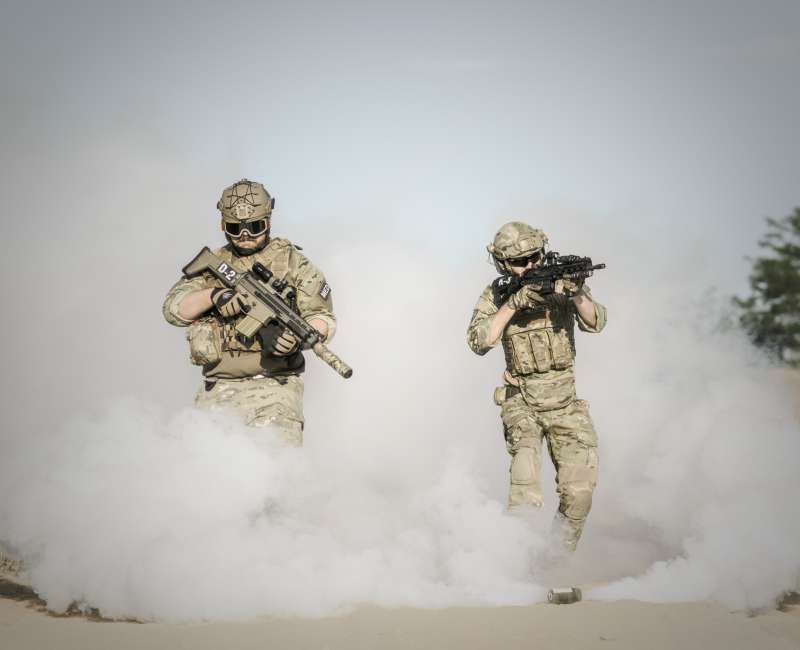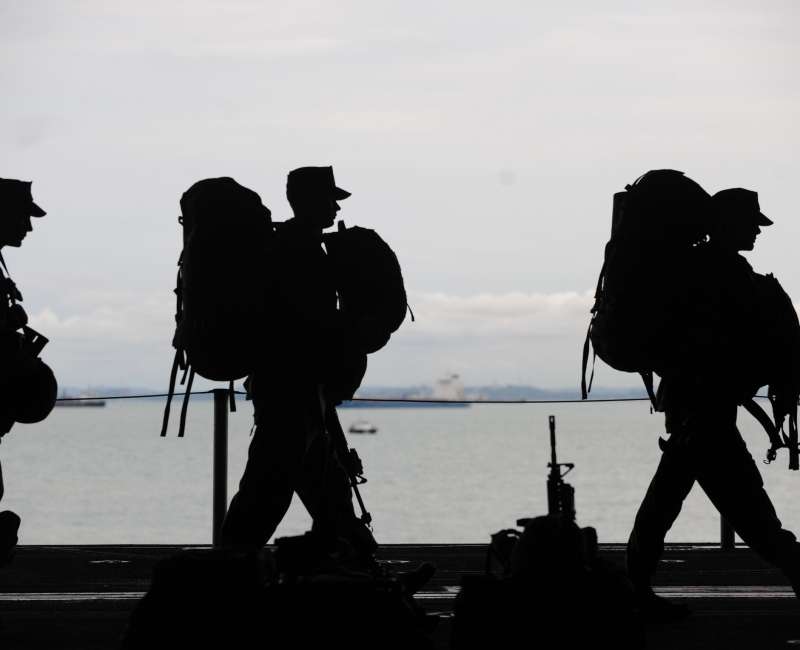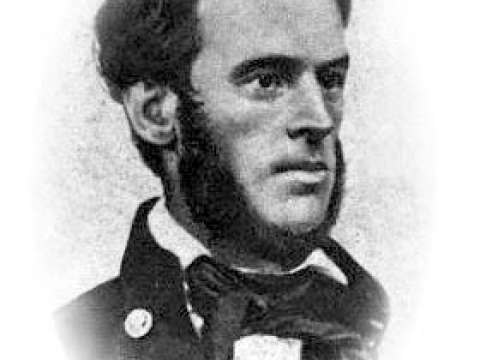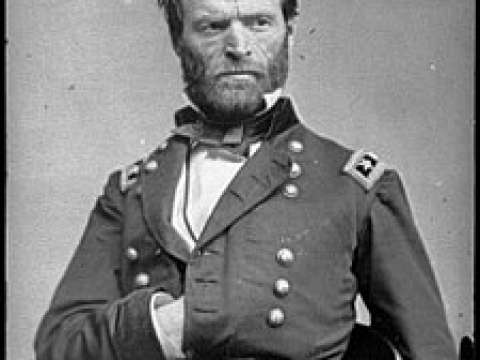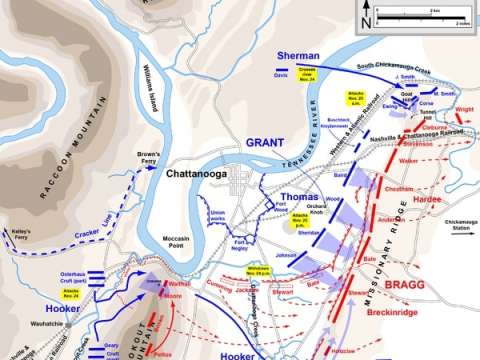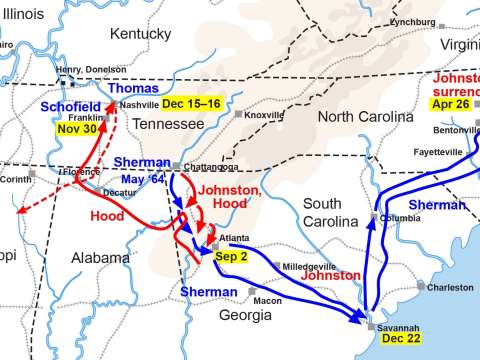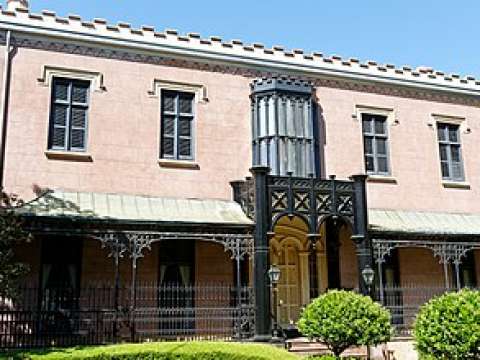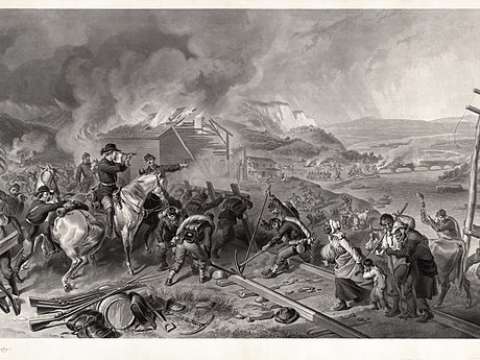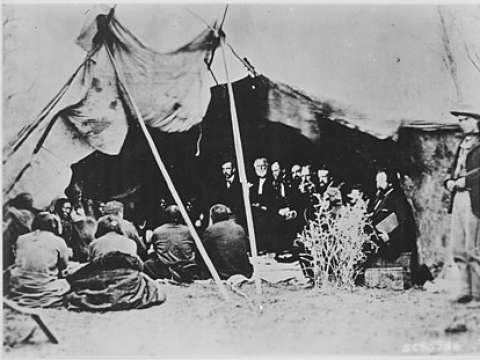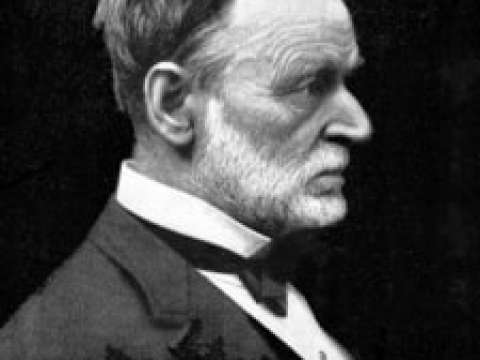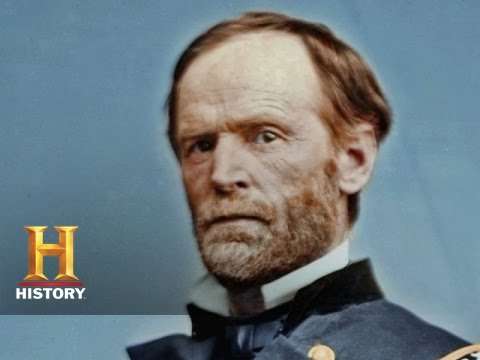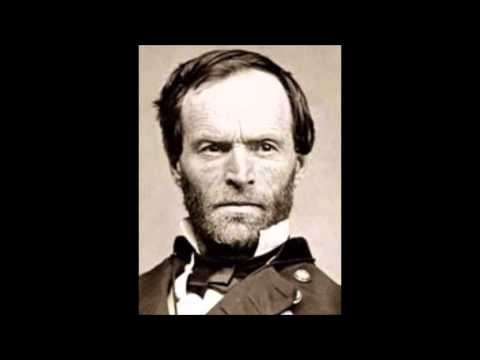

William Tecumseh Sherman (1820-1891)

If I had my choice I would kill every reporter in the world, but I am sure we would be getting reports from Hell before breakfast.
William Tecumseh Sherman was an American soldier, businessman, educator, and author. He served as a general in the Union Army during the American Civil War 1861–1865, receiving recognition for his command of military strategy as well as criticism for the harshness of the scorched earth policies he implemented in conducting total war against the Confederate States. British military theorist and historian B. H. Liddell Hart declared that Sherman was "the first modern general".
Born in Ohio to a politically prominent family, Sherman graduated in 1840 from the United States Military Academy at West Point. He interrupted his military career in 1853 to pursue private business ventures, and at the outbreak of the Civil War he was superintendent of the Louisiana State Seminary of Learning & Military Academy now Louisiana State University. Sherman distinguished himself at the First Battle of Bull Run in 1861, before being transferred to the Western Theater. Stationed in Kentucky, his pessimism about the outlook of the war led to a nervous breakdown that required him to be briefly put on leave. He recovered by forging a close partnership with General Ulysses S. Grant. Sherman served under Grant in 1862 and 1863 during the battles of forts Henry and Donelson, the Battle of Shiloh, the campaigns that led to the fall of the Confederate stronghold of Vicksburg on the Mississippi River, as well as the Chattanooga Campaign that culminated with the routing of the Confederate armies in the state of Tennessee.
In 1864, Sherman succeeded Grant as the Union commander in the Western Theater. Sherman then led the capture of the strategic city of Atlanta, a military success that contributed to the re-election of President Abraham Lincoln. Sherman's subsequent march through Georgia and the Carolinas involved little fighting but large-scale destruction of cotton plantations and other infrastructure, a systematic policy intended to undermine the ability and willingness of the Confederacy to continue fighting. Sherman accepted the surrender of all the Confederate armies in the Carolinas, Georgia, and Florida in April 1865, but the terms that he negotiated were considered too lenient by US Secretary of War Edwin Stanton, who ordered General Grant to modify them.
When Grant became president of the United States in March 1869, Sherman succeeded him as Commanding General of the Army. Sherman served in that capacity from 1869 until 1883 and was responsible for the U.S. Army's engagement in the Indian Wars during that period. He steadfastly refused to be drawn into politics and in 1875 published his Memoirs, one of the best-known first-hand accounts of the Civil War.
Early life
Sherman was born in 1820 in Lancaster, Ohio, near the banks of the Hocking River. His father, Charles Robert Sherman, a successful lawyer who sat on the Ohio Supreme Court, died unexpectedly in 1829. He left his widow, Mary Hoyt Sherman, with eleven children and no inheritance. After his father's death, the nine-year-old Sherman was raised by a Lancaster neighbor and family friend, attorney Thomas Ewing, Sr., a prominent member of the Whig Party who served as senator from Ohio and as the first Secretary of the Interior. Sherman was distantly related to American founding father Roger Sherman and grew to admire him.

Sherman's older brother Charles Taylor Sherman became a federal judge. One of his younger brothers, John Sherman, served as a U.S. senator and Cabinet secretary. Another younger brother, Hoyt Sherman, was a successful banker. Two of his foster brothers served as major generals in the Union Army during the Civil War: Hugh Boyle Ewing, later an ambassador and author, and Thomas Ewing, Jr., who would serve as defense attorney in the military trials of the Lincoln conspirators. Sherman would marry his foster sister, Ellen Boyle Ewing, at age 30 and have eight children with her.
Sherman's given names
Sherman's unusual given name has always attracted considerable attention. Sherman reported that his middle name came from his father having "caught a fancy for the great chief of the Shawnees, 'Tecumseh'". Since an account in a 1932 biography about Sherman, it has often been reported that, as an infant, Sherman was named simply Tecumseh. According to these accounts, Sherman only acquired the name "William" at age nine or ten, after being taken into the Ewing household. His foster mother, Maria Willis Boyle Maria Ewing, was of Irish ancestry and a devout Roman Catholic. Sherman was raised in a Roman Catholic household, although he later left the church, citing the effect of the Civil War on his religious views. According to a story that may be myth, Sherman was baptized in the Ewing home by a Dominican priest, who named him William for the saint's day: possibly June 25, the feast day of Saint William of Montevergine. The story is contested, however. Sherman wrote in his Memoirs that his father named him William Tecumseh; Sherman was baptized by a Presbyterian minister as an infant and given the name William at that time. As an adult, Sherman signed all his correspondence—including to his wife—"W. T. Sherman". His friends and family always called him "Cump".
Military training and service
Senator Ewing secured an appointment for the 16-year-old Sherman as a cadet in the United States Military Academy at West Point, where he roomed and became good friends with another important future Civil War General, George H. Thomas. While there Sherman excelled academically, but he treated the demerit system with indifference. Fellow cadet William Rosecrans would later remember Sherman at West Point as "one of the brightest and most popular fellows" and "a bright-eyed, red-headed fellow, who was always prepared for a lark of any kind". About his time at West Point, Sherman says only the following in his Memoirs:
At the Academy I was not considered a good soldier, for at no time was I selected for any office, but remained a private throughout the whole four years. Then, as now, neatness in dress and form, with a strict conformity to the rules, were the qualifications required for office, and I suppose I was found not to excel in any of these. In studies I always held a respectable reputation with the professors, and generally ranked among the best, especially in drawing, chemistry, mathematics, and natural philosophy. My average demerits, per annum, were about one hundred and fifty, which reduced my final class standing from number four to six.
Upon graduation in 1840, Sherman entered the army as a second lieutenant in the 3rd U.S. Artillery and saw action in Florida in the Second Seminole War against the Seminole tribe. He was later stationed in Georgia and South Carolina. As the foster son of a prominent Whig politician, in Charleston the popular Lt. Sherman moved within the upper circles of Old South society.
While many of his colleagues saw action in the Mexican–American War, Sherman was assigned to administrative duties in the captured territory of California. Along with fellow lieutenants Henry Halleck and Edward Ord, Sherman embarked from New York on the 198-day journey around Cape Horn aboard the converted sloop USS Lexington. During that voyage Sherman grew close to Halleck and Ord, and in his Memoirs relate a hike with Halleck to the summit of Corcovado overlooking Rio de Janeiro in Brazil, notable as the future spot of the Cristo Redentor statue. Sherman and Ord reached the town of Yerba Buena, in California, two days before its name was changed to San Francisco. In 1848, Sherman accompanied the military governor of California, Col. Richard Barnes Mason, in the inspection that officially confirmed that gold had been discovered in the region, thus inaugurating the California Gold Rush. Sherman, along with Ord, assisted in surveys for the sub-divisions of the town that would become Sacramento.
Sherman earned a brevet promotion to captain for his "meritorious service", but his lack of a combat assignment discouraged him and may have contributed to his decision to resign his commission. He would eventually become one of the few high-ranking officers during the Civil War who had not fought in Mexico.
Marriage and business career
In 1850, Sherman was promoted to the substantive rank of captain and on May 1 of that year he married his foster sister, Ellen Boyle Ewing, four years his junior. Rev. James A. Ryder, President of Georgetown College, officiated the Washington D.C. ceremony. President Zachary Taylor, Vice President Millard Fillmore and other political luminaries attended the ceremony. Thomas Ewing was serving as Secretary of the Interior at the time.
Like her mother, Ellen Ewing Sherman was a devout Roman Catholic, and the Shermans' eight children were reared in that faith. In 1864, Ellen took up temporary residence in South Bend, Indiana, to have her young family educated at the University of Notre Dame and St. Mary's College. In 1874, with Sherman having become world-famous, their eldest child, Marie Ewing "Minnie" Sherman, also had a politically prominent wedding, attended by President Ulysses S. Grant and commemorated by a generous gift from the Khedive of Egypt. Eventually, one of Minnie's daughters married a grandson of Confederate general Lewis Addison Armistead. Another of the Sherman daughters, Eleanor, was married to Alexander Montgomery Thackara at General Sherman's home in Washington, D.C., on May 5, 1880. To Sherman's great displeasure and sorrow, his oldest surviving son, Thomas Ewing Sherman, joined the religious order of the Jesuits in 1878 and was ordained as a priest in 1889.

In 1853, Sherman resigned his captaincy and became manager of the San Francisco branch of the St. Louis-based bank Lucas, Turner & Co. He returned to San Francisco at a time of great turmoil in the West. He survived two shipwrecks and floated through the Golden Gate on the overturned hull of a foundering lumber schooner. Sherman suffered from stress-related asthma because of the city's aggressive business culture. Late in life, regarding his time in a San Francisco experiencing a frenzy of real estate speculation, Sherman recalled: "I can handle a hundred thousand men in battle, and take the City of the Sun, but am afraid to manage a lot in the swamp of San Francisco." In 1856, during the vigilante period, he served briefly as a major general of the California militia.
Sherman's San Francisco branch closed in May 1857, and he relocated to New York on behalf of the same bank. When the bank failed during the financial Panic of 1857, he closed the New York branch. In early 1858, he returned to California to wrap up the bank's affairs there. Later in 1858, he moved to Leavenworth, Kansas, where he tried his hand at law practice and other ventures without much success.
Military college superintendent
In 1859, Sherman accepted a job as the first superintendent of the Louisiana State Seminary of Learning & Military Academy in Pineville, Louisiana, a position he sought at the suggestion of Major D. C. Buell and secured because of General George Mason Graham. He proved an effective and popular leader of the institution, which later became Louisiana State University LSU. Colonel Joseph P. Taylor, the brother of the late President Zachary Taylor, declared that "if you had hunted the whole army, from one end of it to the other, you could not have found a man in it more admirably suited for the position in every respect than Sherman."
Although his brother, Congressman John Sherman, was well known for his anti-slavery views, Captain Sherman was not an abolitionist and he had expressed some sympathy for the white Southerners' defense of their agrarian system, including the institution of slavery. On the other hand, Sherman was adamantly opposed to secession. In Louisiana he became a close friend of Professor David F. Boyd, a native of Virginia and an enthusiastic secessionist. Boyd later recalled witnessing that, when news of South Carolina's secession from the United States reached them at the Seminary, "Sherman burst out crying, and began, in his nervous way, pacing the floor and deprecating the step which he feared might bring destruction on the whole country." In what some authors have seen as an accurate prophecy of the conflict that would engulf the United States during the next four years, Boyd recalled Sherman declaring:
You people of the South don't know what you are doing. This country will be drenched in blood, and God only knows how it will end. It is all folly, madness, a crime against civilization! You people speak so lightly of war; you don't know what you're talking about. War is a terrible thing! You mistake, too, the people of the North. They are a peaceable people but an earnest people, and they will fight, too. They are not going to let this country be destroyed without a mighty effort to save it... Besides, where are your men and appliances of war to contend against them? The North can make a steam engine, locomotive, or railway car; hardly a yard of cloth or pair of shoes can you make. You are rushing into war with one of the most powerful, ingeniously mechanical, and determined people on Earth—right at your doors. You are bound to fail. Only in your spirit and determination are you prepared for war. In all else you are totally unprepared, with a bad cause to start with. At first you will make headway, but as your limited resources begin to fail, shut out from the markets of Europe as you will be, your cause will begin to wane. If your people will but stop and think, they must see in the end that you will surely fail.
In January 1861, as more Southern states seceded from the Union, Sherman was required to accept receipt of arms surrendered to the State Militia by the U.S. Arsenal at Baton Rouge, Louisiana. Instead of complying, he resigned his position as superintendent and returned to the North, declaring to the governor of Louisiana, "On no earthly account will I do any act or think any thought hostile ... to the ... United States."
St. Louis interlude
Immediately following his departure from Louisiana, Sherman traveled to Washington, D.C., possibly in the hope of securing a position in the army, and met with Abraham Lincoln in the White House during inauguration week. Sherman expressed concern about the North's poor state of preparedness but found Lincoln unresponsive.
Thereafter, Sherman became president of the St. Louis Railroad, a streetcar company, a position he would hold for only a few months. Thus, he was living in the border state of Missouri as the secession crisis came to a climax. While trying to hold himself aloof from controversy, he observed first-hand the efforts of Congressman Frank Blair, who later served under Sherman, to keep Missouri in the Union. In early April, he declined an offer from the Lincoln administration to take a position in the War Department as a prelude to his becoming Assistant Secretary of War. After the bombardment of Fort Sumter, Sherman hesitated about committing to military service and ridiculed Lincoln's call for 75,000 three-month volunteers to quell secession, reportedly saying: "Why, you might as well attempt to put out the flames of a burning house with a squirt-gun." However, in May, he offered himself for service in the regular army, and his brother Senator John Sherman and other connections maneuvered to get him a commission in the regular army. On June 3, he wrote that "I still think it is to be a long war—very long—much longer than any Politician thinks." He received a telegram summoning him to Washington on June 7.
Civil War service
First commissions and Bull Run
Sherman was first commissioned as colonel of the 13th U.S. Infantry Regiment, effective May 14, 1861. This was a new regiment yet to be raised, and Sherman's first command was actually of a brigade of three-month volunteers who fought in the First Battle of Bull Run on July 21, 1861. This was one of the five brigades in the division commanded by General Daniel Tyler, which was in turn one of the five divisions in the Army of Northeastern Virginia under General Irvin McDowell. The battle ended in a disastrous defeat for the Union, putting an end to the hopes for a rapid resolution of the conflict over secession. Sherman was one of the few Union officers to distinguish himself in the field and historian Donald L. Miller has characterized Sherman's performance at Bull Run as "exemplary". During the fighting, Sherman was grazed by bullets in the knee and shoulder. According to British military historian Brian Holden-Reid, "if Sherman had committed tactical errors during the attack, he more than compensated for these during the subsequent retreat". Holden-Reid also concluded that Sherman "might have been as unseasoned as the men he commanded, but he had not fallen prey to the naïve illusions nursed by so many on the field of First Bull Run."

The outcome at Bull Run caused Sherman to question his own judgment as an officer and the capabilities of his volunteer troops. However, Sherman impressed Abraham Lincoln during the President's visit to the troops on July 23, and Lincoln promoted Sherman to brigadier general of volunteers effective May 17, 1861, with seniority in rank to Ulysses S. Grant, his future commander. Sherman was then assigned to serve under Robert Anderson in the Department of the Cumberland in Louisville, Kentucky. In October, Sherman succeeded Anderson in command of that department. In his memoirs, Sherman would later write that he saw that new assignment as breaking a promise from President Lincoln that he would not be given such a prominent leadership position.
Breakdown
Having succeeded Anderson at Louisville, Sherman now had principal military responsibility for Kentucky, a border state in which Confederate troops held Columbus and Bowling Green and were present near the Cumberland Gap. He became exceedingly pessimistic about the outlook for his command and he complained frequently to Washington, D.C. about shortages, while providing exaggerated estimates of the strength of the rebel forces and requesting inordinate numbers of reinforcements. Critical press reports appeared about him after an October visit to Louisville by the secretary of war, Simon Cameron, and in early November 1861 Sherman insisted that he be relieved. He was promptly replaced by Brigadier General Don Carlos Buell and transferred to St. Louis, Missouri. In December, he was put on leave by Maj. Gen. Henry W. Halleck, commander of the Department of the Missouri, who considered him unfit for duty. Sherman went to Lancaster, Ohio, to recuperate. While he was at home, his wife Ellen wrote to his brother, Senator John Sherman, seeking advice. She complained of "that melancholy insanity to which your family is subject". In his private correspondence, Sherman later wrote that the concerns of command "broke me down" and admitted to having contemplated suicide. His problems were compounded when the Cincinnati Commercial described him as "insane".
By mid-December 1861 Sherman had recovered sufficiently to return to service under Halleck in the Department of the Missouri. In March, Halleck's command was redesignated the Department of the Mississippi and enlarged to unify command in the West. Sherman's initial assignments were rear-echelon commands, first of an instructional barracks near St. Louis and then in command of the District of Cairo. Operating from Paducah, Kentucky, he provided logistical support for the operations of Brig. Gen. Ulysses S. Grant to capture Fort Donelson February 1862. Grant, the previous commander of the District of Cairo, had recently won a major victory at Fort Henry February 6, 1862 and been given command of the ill-defined District of West Tennessee. Although Sherman was technically the senior officer at this time, he wrote to Grant, "I feel anxious about you as I know the great facilities have faith in you—Command me in any way."
Shiloh
After Grant captured Fort Donelson, Sherman got his wish to serve under Grant when he was assigned on March 1, 1862, to the Army of West Tennessee as commander of the 5th Division. His first major test under Grant was at the Battle of Shiloh. The massive Confederate attack on the morning of April 6, 1862, took most of the senior Union commanders by surprise. Sherman had dismissed the intelligence reports received from militia officers, refusing to believe that Confederate General Albert Sidney Johnston would leave his base at Corinth. He took no precautions beyond strengthening his picket lines, and refused to entrench, build abatis, or push out reconnaissance patrols. At Shiloh, he may have wished to avoid appearing overly alarmed in order to escape the kind of criticism he had received in Kentucky. He had written to his wife that, if he took more precautions, "they'd call me crazy again".

Despite being caught unprepared by the attack, Sherman rallied his division and conducted an orderly, fighting retreat that helped avert a disastrous Union rout. Finding Grant at the end of the day sitting under an oak tree in the darkness and smoking a cigar, Sherman felt, in his words, "some wise and sudden instinct not to mention retreat". In what would become one of the most notable conversations of the war, Sherman said simply: "Well, Grant, we've had the devil's own day, haven't we?" After a puff of his cigar, Grant replied calmly: "Yes. Lick 'em tomorrow, though." Sherman proved instrumental to the successful Union counterattack of April 7, 1862. At Shiloh, Sherman was wounded twice—in the hand and shoulder—and had three horses shot out from under him. His performance was praised by Grant and Halleck and after the battle he was promoted to major general of volunteers, effective May 1, 1862.
Beginning in late April, a Union force of 100,000 moved slowly against Corinth, under Halleck's command with Grant relegated to second-in-command; Sherman commanded the division on the extreme right of the Union's right wing under George H. Thomas. Shortly after the Union forces occupied Corinth on May 30, Sherman persuaded Grant not to leave his command, despite the serious difficulties he was having with Halleck. Sherman offered Grant an example from his own life, "Before the battle of Shiloh, I was cast down by a mere newspaper assertion of 'crazy', but that single battle gave me new life, and I'm now in high feather." He told Grant that, if he remained in the army, "some happy accident might restore you to favor and your true place". In July, Grant's situation improved when Halleck left for the East to become general-in-chief, and Sherman became the military governor of occupied Memphis.
Vicksburg
According to historian John D. Winters's The Civil War in Louisiana (1963), at this time Sherman
... had yet to display any marked talents for leadership. Sherman, beset by hallucinations and unreasonable fears and finally contemplating suicide, had been relieved from command in Kentucky. He later began a new climb to success at Shiloh and Corinth under Grant. Still, if he muffed his Vicksburg assignment, which had begun unfavorably, he would rise no higher. As a man, Sherman was an eccentric mixture of strength and weakness. Although he was impatient, often irritable and depressed, petulant, headstrong, and unreasonably gruff, he had solid soldierly qualities. His men swore by him, and most of his fellow officers admired him.
In Sherman's case, this was in part because he developed close personal ties to Grant during the two years they served together in the West. During the long and complicated campaign against Vicksburg, one newspaper complained that the "army was being ruined in mud-turtle expeditions, under the leadership of a drunkard was a lunatic".
Sherman's military record in 1862–63 was mixed. In December 1862, forces under his command suffered a severe repulse at the Battle of Chickasaw Bayou, just north of Vicksburg, Mississippi. Soon after, his XV Corps was ordered to join Maj. Gen. John A. McClernand in his successful assault on Arkansas Post, generally regarded as a politically motivated distraction from the effort to capture Vicksburg. Before the Vicksburg Campaign in the spring of 1863, Sherman expressed serious reservations about the wisdom of Grant's unorthodox strategy, but he went on to perform well in that campaign under Grant's supervision.
The historian John D. Winters in The Civil War in Louisiana 1963 describes Sherman:
Chattanooga
After the surrender of Vicksburg to the Union forces under Grant on July 4, 1863, Sherman was given the rank of brigadier general in the regular army, in addition to his rank as a major general of volunteers. Sherman's family came from Ohio to visit his camp near Vicksburg; his nine-year-old son, Willie, the Little Sergeant, died from typhoid fever contracted during the trip.
Command in the West was unified under Grant Military Division of the Mississippi, and Sherman succeeded Grant in command of the Army of the Tennessee. Following the defeat of the Army of the Cumberland at the Battle of Chickamauga by Confederate General Braxton Bragg's Army of Tennessee, the army was besieged in Chattanooga, Tennessee. Sherman's troops were sent to relieve them. While traveling to Chattanooga, Sherman departed Memphis on a train that arrived at the Battle of Collierville, Tennessee, while the Union garrison there was under attack on October 11, 1863. General Sherman took command of the 550 men and successfully defended against an attack of 3,500 Confederate cavalry.

During the Chattanooga Campaign in November, under Grant's overall command, Sherman quickly took his assigned target of Billy Goat Hill at the north end of Missionary Ridge, only to discover that it was not part of the ridge at all, but rather a detached spur separated from the main spine by a rock-strewn ravine. When he attempted to attack the main spine at Tunnel Hill, his troops were repeatedly repelled by Patrick Cleburne's heavy division, the best unit in Bragg's army. Sherman's efforts were assisted by George Henry Thomas's army's successful assault on the center of the Confederate line, a movement originally intended as a diversion. Subsequently, Sherman led a column to relieve Union forces under Ambrose Burnside thought to be in peril at Knoxville. In February 1864, he led an expedition to Meridian, Mississippi, to disrupt Confederate infrastructure.
Atlanta
Despite this mixed record, Sherman enjoyed Grant's confidence and friendship. When Lincoln called Grant east in the spring of 1864 to take command of all the Union armies, Grant appointed Sherman by then known to his soldiers as "Uncle Billy" to succeed him as head of the Military Division of the Mississippi, which entailed command of Union troops in the Western Theater of the war. As Grant took overall command of the armies of the United States, Sherman wrote to him outlining his strategy to bring the war to an end concluding that "if you can whip Lee and I can march to the Atlantic I think ol' Uncle Abe will give us twenty days leave to see the young folks."
Sherman proceeded to invade the state of Georgia with three armies: the 60,000-strong Army of the Cumberland under George Henry Thomas, the 25,000-strong Army of the Tennessee under James B. McPherson, and the 13,000-strong Army of the Ohio under John M. Schofield. He commanded a lengthy campaign of maneuver through mountainous terrain against Confederate General Joseph E. Johnston's Army of Tennessee, attempting a direct assault only at the Battle of Kennesaw Mountain. In July, the cautious Johnston was replaced by the more aggressive John Bell Hood, who played to Sherman's strength by challenging him to direct battles on open ground. Meanwhile, in August, Sherman "learned that I had been commissioned a major-general in the regular army, which was unexpected, and not desired until successful in the capture of Atlanta".

Sherman's Atlanta Campaign concluded successfully on September 2, 1864, with the capture of the city, which Hood had been forced to abandon. The fall of Atlanta had a major political impact in the North: it caused the collapse of the once powerful "Copperhead" faction within the Democratic Party, which had advocated immediate peace negotiations with the Confederacy. Sherman's military victory thus effectively ensured Abraham Lincoln's presidential re-election in November.
After ordering almost all civilians to leave the city in September, Sherman gave instructions that all military and government buildings in Atlanta be burned, although many private homes and shops were burned as well. This was to set a precedent for future behavior by his armies. The capture of the city of Atlanta made General Sherman a household name.
March to the Sea
During September and October, Sherman and Hood played cat-and-mouse in north Georgia and Alabama as Hood threatened Sherman's communications to the north. Eventually, Sherman won approval from his superiors for a plan to cut loose from his communications and march south, having advised Grant that he could "make Georgia howl". This created the threat that Hood would move north into Tennessee. Trivializing that threat, Sherman reportedly said that he would "give his rations" to go in that direction as "my business is down south". However, Sherman left forces under Maj. Gens. George H. Thomas and John M. Schofield to deal with Hood; their forces eventually smashed Hood's army in the battles of Franklin November 30 and Nashville December 15–16. Meanwhile, after the November elections, Sherman began a march on November 15 with 62,000 men to the port of Savannah, Georgia, living off the land and causing, by his own estimate, more than $100 million in property damage. Sherman called this harsh tactic of material war "hard war," often seen as a species of total war. At the end of this campaign, known as Sherman's March to the Sea, his troops captured Savannah on December 21, 1864. Sherman then dispatched a message to Lincoln, offering him the city as a Christmas present.

Sherman's success in Georgia received ample coverage in the Northern press at a time when Grant seemed to be making little progress in his fight against Confederate General Robert E. Lee's Army of Northern Virginia. A bill was introduced in Congress to promote Sherman to Grant's rank of lieutenant general, probably with a view towards having him replace Grant as commander of the Union Army. Sherman wrote both to his brother, Senator John Sherman, and to General Grant vehemently repudiating any such promotion. According to a war-time account, it was around this time that Sherman made his memorable declaration of loyalty to Grant:
General Grant is a great general. I know him well. He stood by me when I was crazy, and I stood by him when he was drunk; and now, sir, we stand by each other always.
While in Savannah, Sherman learned from a newspaper that his infant son Charles Celestine had died during the Savannah Campaign; the general had never seen the child.
Final campaigns in the Carolinas
Grant then ordered Sherman to embark his army on steamers and join the Union forces confronting Lee in Virginia, but Sherman instead persuaded Grant to allow him to march north through the Carolinas, destroying everything of military value along the way, as he had done in Georgia. He was particularly interested in targeting South Carolina, the first state to secede from the Union, because of the effect that it would have on Southern morale. His army proceeded north through South Carolina against light resistance from the troops of Confederate General Joseph E. Johnston. Upon hearing that Sherman's men were advancing on corduroy roads through the Salkehatchie swamps at a rate of a dozen miles per day, Johnston "made up his mind that there had been no such army in existence since the days of Julius Caesar".
Sherman captured the state capital of Columbia, South Carolina, on February 17, 1865. Fires began that night and by next morning most of the central city was destroyed. The burning of Columbia has engendered controversy ever since, with some claiming the fires were accidental, others a deliberate act of vengeance, and still others that the retreating Confederates burned bales of cotton on their way out of town.

Local Native American Lumbee guides helped Sherman's army cross the Lumber River, which was flooded by torrential rains, into North Carolina. According to Sherman, the trek across the Lumber River, and through the swamps, pocosins, and creeks of Robeson County was "the damnedest marching I ever saw". Thereafter, his troops did little damage to the civilian infrastructure, as North Carolina, unlike its southern neighbor, was regarded by his men as a reluctant Confederate state, having been the second from last state to secede from the Union, before Tennessee. Sherman's final significant military engagement was a victory over Johnston's troops at the Battle of Bentonville, March 19–21. He soon rendezvoused at Goldsborough, North Carolina, with Union troops awaiting him there after the capture of Fort Fisher and Wilmington.
In late March, Sherman briefly left his forces and traveled to City Point, Virginia, to consult with Grant. Lincoln happened to be at City Point at the same time, allowing the only three-way meetings of Lincoln, Grant, and Sherman during the war.
Confederate surrender
Following Lee's surrender to Grant at Appomattox Court House and the assassination of President Lincoln, Sherman met with Johnston in mid-April at Bennett Place in Durham, North Carolina, to negotiate a Confederate surrender. At the insistence of Johnston and of Confederate President Jefferson Davis, Sherman conditionally agreed to generous terms that dealt with both political and military issues. Sherman thought that those terms were consistent with the views Lincoln had expressed at City Point, but the general had not been given the authority, by General Grant, the newly installed President Andrew Johnson, or the Cabinet, to offer those terms.

The government in Washington, D.C., refused to approve Sherman's terms and the Secretary of War, Edwin M. Stanton, denounced Sherman publicly, precipitating a long-lasting feud between the two men. Confusion over this issue lasted until April 26, 1865, when Johnston, ignoring instructions from President Davis, agreed to purely military terms and formally surrendered his army and all the Confederate forces in the Carolinas, Georgia, and Florida, in what was the largest single capitulation of the war. Sherman proceeded with 60,000 of his troops to Washington, D.C., where they marched in the Grand Review of the Armies, on May 24, 1865, and were then disbanded. Having become the second most important general in the Union army, he thus had come full circle to the city where he started his war-time service as colonel of a non-existent infantry regiment.
Slavery and emancipation
Sherman was not an abolitionist before the war and, like others of his time and background, he did not believe in "Negro equality". Before the war, Sherman at times even expressed some sympathy with the view of Southern whites that the black race was benefiting from slavery, although he opposed breaking up slave families and advocated teaching slaves to read and write. During the Civil War, Sherman declined to employ black troops in his armies.
Sherman's military campaigns of 1864 and 1865 freed many slaves, who greeted him "as a second Moses or Aaron" and joined his marches through Georgia and the Carolinas by the tens of thousands. The fate of these refugees became a pressing military and political issue. Some abolitionists accused Sherman of doing little to alleviate the precarious living conditions of the freed slaves. To address this issue, on January 12, 1865, Sherman met in Savannah with Secretary of War Stanton and with twenty local black leaders. After Sherman's departure, Garrison Frazier, a Baptist minister, declared in response to an inquiry about the feelings of the black community:
We looked upon General Sherman, prior to his arrival, as a man, in the providence of God, specially set apart to accomplish this work, and we unanimously felt inexpressible gratitude to him, looking upon him as a man that should be honored for the faithful performance of his duty. Some of us called upon him immediately upon his arrival, and it is probable he did not meet [Secretary Stanton] with more courtesy than he met us. His conduct and deportment toward us characterized him as a friend and a gentleman.
Four days later, Sherman issued his Special Field Orders, No. 15. The orders provided for the settlement of 40,000 freed slaves and black refugees on land expropriated from white landowners in South Carolina, Georgia, and Florida. Sherman appointed Brig. Gen. Rufus Saxton, an abolitionist from Massachusetts who had previously directed the recruitment of black soldiers, to implement that plan. Those orders, which became the basis of the claim that the Union government had promised freed slaves "40 acres and a mule", were revoked later that year by President Andrew Johnson.
Although the context is often overlooked, and the quotation usually chopped off, one of Sherman's statements about his hard-war views arose in part from the racial attitudes summarized above. In his Memoirs, Sherman noted political pressures in 1864–1865 to encourage the escape of slaves, in part to avoid the possibility that "able-bodied slaves will be called into the military service of the rebels". Sherman thought concentration on such policies would have delayed the "successful end" of the war and the " all slaves". He went on to summarize vividly his hard-war philosophy and to add, in effect, that he really did not want the help of liberated slaves in subduing the South:
My aim then was to whip the rebels, to humble their pride, to follow them to their inmost recesses, and make them fear and dread us. "Fear of the Lord is the beginning of wisdom." I did not want them to cast in our teeth what General Hood had once done at Atlanta, that we had to call on their slaves to help us to subdue them. But, as regards kindness to the race ..., I assert that no army ever did more for that race than the one I commanded at Savannah.
Sherman's views on race evolved throughout his life. He dealt in a friendly and unaffected way with the black people that he met during his career, and in 1888, towards the end of his life, he published an essay in the North American Review defending the full civil rights of black citizens in the former Confederacy.
Strategies
Sherman's record as a tactician was mixed, and his military legacy rests primarily on his command of logistics and on his brilliance as a strategist. The influential 20th-century British military historian and theorist B. H. Liddell Hart ranked Sherman as one of the most important strategists in the annals of war, along with Scipio Africanus, Belisarius, Napoleon Bonaparte, T. E. Lawrence, and Erwin Rommel. Liddell Hart credited Sherman with mastery of maneuver warfare also known as the "indirect approach", as demonstrated by his series of turning movements against Johnston during the Atlanta Campaign. Liddell Hart also stated that study of Sherman's campaigns had contributed significantly to his own "theory of strategy and tactics in mechanized warfare", which had in turn influenced Heinz Guderian's doctrine of Blitzkrieg and Rommel's use of tanks during the Second World War. Another World War II-era student of Liddell Hart's writings about Sherman was George S. Patton, who "'spent a long vacation studying Sherman's campaigns on the ground in Georgia and the Carolinas, with the aid of plans, in super-Sherman style'".
Sherman's greatest contribution to the war, the strategy of total warfare—endorsed by General Grant and President Lincoln—has been the subject of controversy. Sherman himself downplayed his role in conducting total war, often saying that he was simply carrying out orders as best he could in order to fulfill his part of Grant's master plan for ending the war.
Total warfare
Like Grant, Sherman was convinced that the Confederacy's strategic, economic, and psychological ability to wage further war needed to be definitively crushed if the fighting were to end. Therefore, he believed that the North had to conduct its campaign as a war of conquest and employ scorched earth tactics to break the backbone of the rebellion. He called this strategy "hard war".
Sherman's advance through Georgia and South Carolina was characterized by widespread destruction of civilian supplies and infrastructure. Although looting was officially forbidden, historians disagree on how well this regulation was enforced.
The damage done by Sherman was almost entirely limited to the destruction of property. Though exact figures are not available, the loss of civilian life appears to have been very small. Consuming supplies, wrecking infrastructure, and undermining morale were Sherman's stated goals, and several of his Southern contemporaries noted this and commented on it. For instance, Alabama-born Major Henry Hitchcock, who served in Sherman's staff, declared that "it is a terrible thing to consume and destroy the sustenance of thousands of people," but if the scorched earth strategy served "to paralyze their husbands and fathers who are fighting ... it is mercy in the end".

The severity of the destructive acts by Union troops was significantly greater in South Carolina than in Georgia or North Carolina. This appears to have been a consequence of the animosity among both Union soldiers and officers to the state that they regarded as the "cockpit of secession". One of the most serious accusations against Sherman was that he allowed his troops to burn the city of Columbia. In 1867, Gen. O. O. Howard, commander of Sherman's 15th Corps, reportedly said, "It is useless to deny that our troops burnt Columbia, for I saw them in the act." However, Sherman himself stated that "f I had made up my mind to burn Columbia I would have burnt it with no more feeling than I would a common prairie dog village; but I did not do it ..." Sherman's official report on the burning placed the blame on Confederate Lt. Gen. Wade Hampton III, who Sherman said had ordered the burning of cotton in the streets. In his memoirs, Sherman said, "In my official report of this conflagration I distinctly charged it to General Wade Hampton, and confess I did so pointedly to shake the faith of his people in him, for he was in my opinion a braggart and professed to be the special champion of South Carolina." Historian James M. McPherson has concluded that:
The fullest and most dispassionate study of this controversy blames all parties in varying proportions—including the Confederate authorities for the disorder that characterized the evacuation of Columbia, leaving thousands of cotton bales on the streets (some of them burning) and huge quantities of liquor undestroyed ... Sherman did not deliberately burn Columbia; a majority of Union soldiers, including the general himself, worked through the night to put out the fires.
In this general connection, it is also noteworthy that Sherman and his subordinates particularly John A. Logan took steps to protect Raleigh, North Carolina, from acts of revenge after the assassination of President Lincoln.
Modern assessment
After the fall of Atlanta in 1864, Sherman ordered the city's evacuation. When the city council appealed to him to rescind that order, on the grounds that it would cause great hardship to women, children, the elderly, and others who bore no responsibility for the conduct of the war, Sherman sent a written response in which he sought to articulate his conviction that a lasting peace would be possible only if the Union were restored, and that he was therefore prepared to do all he could do to quash the rebellion:
You cannot qualify war in harsher terms than I will. War is cruelty, and you cannot refine it; and those who brought war into our country deserve all the curses and maledictions a people can pour out. I know I had no hand in making this war, and I know I will make more sacrifices to-day than any of you to secure peace. But you cannot have peace and a division of our country. If the United States submits to a division now, it will not stop, but will go on until we reap the fate of Mexico, which is eternal war ... I want peace, and believe it can only be reached through union and war, and I will ever conduct war with a view to perfect and early success. But, my dear sirs, when peace does come, you may call on me for anything. Then will I share with you the last cracker, and watch with you to shield your homes and families against danger from every quarter.
Literary critic Edmund Wilson found in Sherman's Memoirs a fascinating and disturbing account of an "appetite for warfare" that "grows as it feeds on the South". Former U.S. Defense Secretary Robert McNamara refers equivocally to the statement that "war is cruelty and you cannot refine it" in both the book Wilson's Ghost and in his interview for the film The Fog of War.
But when comparing Sherman's scorched-earth campaigns to the actions of the British Army during the Second Boer War 1899–1902—another war in which civilians were targeted because of their central role in sustaining a belligerent power—South African historian Hermann Giliomee claims that it "looks as if Sherman struck a better balance than the British commanders between severity and restraint in taking actions proportional to legitimate needs". The admiration of scholars such as Victor Davis Hanson, B. H. Liddell Hart, Lloyd Lewis, and John F. Marszalek for General Sherman owes much to what they see as an approach to the exigencies of modern armed conflict that was both effective and principled.
In May 1865, after the major Confederate armies had surrendered, Sherman wrote in a personal letter:
I confess, without shame, I am sick and tired of fighting—its glory is all moonshine; even success the most brilliant is over dead and mangled bodies, with the anguish and lamentations of distant families, appealing to me for sons, husbands and fathers ... tis only those who have never heard a shot, never heard the shriek and groans of the wounded and lacerated ... that cry aloud for more blood, more vengeance, more desolation.
Departmental commander and Reconstruction
In June 1865, two months after Robert E. Lee's surrender at Appomattox, General Sherman received his first postwar command, originally called the Military Division of the Mississippi, later the Military Division of the Missouri, which came to comprise the territory between the Mississippi River and the Rocky Mountains. Sherman's efforts in that position were focused on protecting the main wagon roads, such as the Oregon, Bozeman and Santa Fe Trails. Tasked with guarding a vast territory with a limited force, Sherman was wary of the multitude of requests by territories and settlements for protection.
One of Sherman's main concerns in postwar commands was to protect the construction and operation of the railroads from attack by hostile Indians. Sherman's views on Indian matters were often strongly expressed. He regarded the railroads "as the most important element now in progress to facilitate the military interests of our Frontier". Hence, in 1867, he wrote to Grant that "we are not going to let a few thieving, ragged Indians check and stop the progress of ". After the 1866 Fetterman Massacre, Sherman wrote Grant that "we must act with vindictive earnestness against the Sioux, even to their extermination, men, women and children".

Despite this language, there was little large-scale military action taken against the Indians during the first three years of Sherman's tenure, as Sherman was willing to let the process of negotiations play out in order to buy time to procure more troops and allow the completion of the Union Pacific and Kansas Pacific Railroads. During his time as departmental commander, Sherman was a member of the Indian Peace Commission. Though the commission was responsible for the negotiation of the Medicine Lodge Treaty and the Sioux Treaty of 1868, Sherman was not particularly privy in either due to being called away to Washington during the negotiations of both. In one such instance, he was called to testify in the impeachment trial of Andrew Johnson. However, Sherman was successful in negotiating other treaties, such as the removal of Navajos from the Bosque Redondo to traditional lands in Western New Mexico. When the Medicine Lodge Treaty was broken in 1868, Sherman authorized his subordinate in Missouri, Philip Sheridan, to conduct the Winter Campaign of 1868–69 of which the Battle of Washita River was a part, where Sheridan used hard-war tactics similar to those he and Sherman had employed in the Civil War. Sherman was also involved with the trial of Satanta and Big Tree: he ordered that the two chiefs should be tried as common criminals for their role in the Warren Wagon Train Raid, a raid that came dangerously close to killing Sherman himself.
General of the Army
On July 25, 1866, Congress created the rank of General of the Army for Grant and then promoted Sherman to lieutenant general. When Grant became president in 1869, Sherman was appointed Commanding General of the United States Army and promoted to General of the Army. After the death of John A. Rawlins, Sherman also served for one month as interim Secretary of War. His tenure as commanding general was marred by political difficulties, many of which stemmed from disagreements with Secretaries of War Rawlins and William W. Belknap, whom Sherman felt had usurped too much of the Commanding General's powers, reducing him to a sinecure office. Sherman also clashed with Eastern humanitarians, who were critical of the Army's killing of Indians and had apparently found an ally in President Grant. To escape these difficulties, from 1874 to 1876, he moved his headquarters to St. Louis, Missouri, returning to Washington only upon the appointment of Alphonso Taft as Secretary of War and the promise of more authority.
Much of Sherman's time as Commanding General was devoted to making the Western and Plains states safe for settlement through the continuation of the Indian Wars, which included three significant campaigns: the Modoc War, the Great Sioux War of 1876, and the Nez Perce War. The displacement of Indians was facilitated by the growth of the railroad and the eradication of the buffalo. Sherman believed that the intentional eradication of the buffalo should be encouraged as a means of weakening Indian resistance to assimilation. He voiced this view in remarks to a joint session of the Texas legislature in 1875. However he never engaged in any program to actually eradicate the buffalo. During this time, Sherman reorganized frontier forts to reflect the shifting frontier.

After George Armstrong Custer's defeat at the Battle of Little Bighorn, Sherman wrote that "hostile savages like Sitting Bull and his band of outlaw Sioux ... must feel the superior power of the Government". He further wrote that "during an assault, the soldiers can not pause to distinguish between male and female, or even discriminate as to age". Despite his harsh treatment of the warring tribes, Sherman spoke out against the unfair way speculators and government agents treated the natives within the reservations.
In 1875 Sherman published his memoirs in two volumes. According to critic Edmund Wilson, Sherman:
[H]ad a trained gift of self-expression and was, as Mark Twain says, a master of narrative. [In his Memoirs] the vigorous account of his pre-war activities and his conduct of his military operations is varied in just the right proportion and to just the right degree of vivacity with anecdotes and personal experiences. We live through his campaigns ... in the company of Sherman himself. He tells us what he thought and what he felt, and he never strikes any attitudes or pretends to feel anything he does not feel.
During the election of 1876, Southern Democrats who supported Wade Hampton for governor used mob violence to attack and intimidate African American voters in Charleston, South Carolina. Republican Governor Daniel Chamberlain appealed to President Ulysses S. Grant for military assistance. In October 1876, Grant, after issuing a proclamation, instructed Sherman to gather all available Atlantic region troops and dispatch them to South Carolina to stop the mob violence.
On June 19, 1879, Sherman delivered an address to the graduating class of the Michigan Military Academy, in which he may have uttered the famous phrase "War is Hell". On April 11, 1880, he addressed a crowd of more than 10,000 in Columbus, Ohio: "There is many a boy here today who looks on war as all glory, but, boys, it is all hell." In 1945, President Harry S. Truman would say: "Sherman was wrong. I'm telling you I find peace is hell."
One of Sherman's significant contributions as head of the Army was the establishment of the Command School now the Command and General Staff College at Fort Leavenworth in 1881. Sherman stepped down as commanding general on November 1, 1883, and retired from the army on February 8, 1884.
Later years
He lived most of the rest of his life in New York City. He was devoted to the theater and to amateur painting and was much in demand as a colorful speaker at dinners and banquets, in which he indulged a fondness for quoting Shakespeare. During this period, he stayed in contact with war veterans, and through them accepted honorary membership into the Phi Kappa Psi fraternity and the Irving Literary Society. Sherman was proposed as a Republican candidate for the presidential election of 1884, but declined as emphatically as possible, saying, "I will not accept if nominated and will not serve if elected." Such a categorical rejection of a candidacy is now referred to as a "Shermanesque statement". On June 7, 1865 he delivered the commencement speech at the University of Notre Dame.

In 1888 he joined the newly formed Boone and Crockett Club, a wildlife conservation organization founded by Theodore Roosevelt and George Bird Grinnell.
Death
Sherman died of pneumonia in New York City at 1:50 PM on February 14, 1891, six days after his 71st birthday. President Benjamin Harrison sent a telegram to General Sherman's family and ordered all national flags to be flown at half mast. Harrison, in a message to the Senate and the House of Representatives, wrote that:
He was an ideal soldier, and shared to the fullest the esprit de corps of the army, but he cherished the civil institutions organized under the Constitution, and was only a soldier that these might be perpetuated in undiminished usefulness and honor.
On February 19, a funeral service was held at his home, followed by a military procession. General Joseph E. Johnston, the Confederate officer who had commanded the resistance to Sherman's troops in Georgia and the Carolinas, served as a pallbearer in New York City. It was a bitterly cold day and a friend of Johnston, fearing that the general might become ill, asked him to put on his hat. Johnston replied: "If I were in place, and he were standing in mine, he would not put on his hat." Johnston did catch a serious cold and died one month later of pneumonia.
General Sherman's body was then transported to St. Louis, where another service was conducted on February 21, 1891 at a local Catholic church. His son, Thomas Ewing Sherman, a Jesuit priest, presided over his father's funeral mass. Sherman is buried in Calvary Cemetery in St. Louis.
Religious views
Sherman's birth family was Presbyterian and he was originally baptized as such. His foster family, including his future wife Ellen, were devout Catholics, and Sherman was re-baptized and later married in the Catholic rite. According to his son Thomas, who became a Catholic priest, Sherman attended the Catholic Church until the outbreak of the Civil War, but not thereafter. In 1888, Sherman wrote publicly that "my immediate family are strongly Catholic. I am not and cannot be." A memoirist reports that Sherman told him in 1887 that "my family is strongly Roman Catholic, but I am not." Sherman wrote his wife Ellen Ewing in 1842 that "I believe in good works rather than faith."
Monuments
Major monuments to Sherman include the gilded bronze Sherman Memorial 1902 by Augustus Saint-Gaudens at the main entrance to Central Park in New York City, and the Sherman Monument 1903 by Carl Rohl-Smith near President's Park in Washington, D.C. The Sherman Monument 1900 in Muskegon, Michigan features a bronze statue by John Massey Rhind, and the Sherman Monument 1903 in Arlington National Cemetery features a smaller version of Saint-Gaudens's equestrian statue. Copies of Saint-Gaudens's Bust of William Tecumseh Sherman are in the Metropolitan Museum of Art, and elsewhere.
Other posthumous tributes include Sherman Circle in the Petworth neighborhood of Washington, DC, the naming of the World War II M4 Sherman tank, and the "General Sherman" Giant Sequoia tree, the most massive documented single-trunk tree in the world.
- Sherman Monument 1900, Muskegon, Michigan
- General William Tecumseh Sherman Monument 1903, Washington, D.C.
Historiography
In the years immediately after the war, Sherman's conservative politics was attractive to white Southerners. By the 1880s, however, Southern "Lost Cause" writers began to demonize Sherman for his attacks on civilians in the "March". The magazine Confederate Veteran, based in Nashville, gave Sherman more attention than anyone else, in part to enhance the visibility of the western theater. His devastation of railroads and plantations mattered less than the March's insult to southern dignity, especially its unprotected womanhood. Moody criticizes English historians Field Marshal Viscount Garnet Wolseley, Maj. Gen. John F. C. Fuller, and especially Capt. Basil H. Liddell Hart, who built up Sherman's reputation by exaggerating his "atrocities" and filtering his actions through their ideas about modern warfare.
By contrast Sherman was a popular hero in the North and well regarded by his soldiers. Military historians have paid special attention to his Atlanta campaign and the March to the Sea, generally giving him high marks as an innovative strategist and quick-witted tactician.
Autobiography and memoirs
Around 1868, Sherman began to write a "private" recollection for his children about his life before the Civil War, identified now as his unpublished "Autobiography, 1828–1861". This manuscript is held by the Ohio Historical Society. Much of the material in it would eventually be incorporated in revised form in his memoirs.
In 1875, ten years after the end of the Civil War, Sherman became one of the first Civil War generals to publish a memoir. His Memoirs of General William T. Sherman. By Himself, published by D. Appleton & Co., in two volumes, began with the year 1846 when the Mexican War began and ended with a chapter about the "military lessons of the war". The memoirs were controversial, and sparked complaints from many quarters. Grant serving as president when Sherman's memoirs first appeared later remarked that others had told him that Sherman treated Grant unfairly but "when I finished the book, I found I approved every word; that ... it was a true book, an honorable book, creditable to Sherman, just to his companions—to myself particularly so—just such a book as I expected Sherman would write."
In 1886, after the publication of Grant's memoirs, Sherman produced a "second edition, revised and corrected" of his memoirs with Appleton. The new edition added a second preface, a chapter about his life up to 1846, a chapter concerning the post-war period ending with his 1884 retirement from the army, several appendices, portraits, improved maps, and an index. For the most part, Sherman refused to revise his original text on the ground that "I disclaim the character of historian, but assume to be a witness on the stand before the great tribunal of history" and "any witness who may disagree with me should publish his own version of facts in the truthful narration of which he is interested". However, Sherman did add the appendices, in which he published the views of some others.

Subsequently, Sherman shifted to the publishing house of Charles L. Webster & Co., the publisher of Grant's memoirs. The new publishing house brought out a "third edition, revised and corrected" in 1890. This difficult-to-find edition was substantively identical to the second except for the probable omission of Sherman's short 1875 and 1886 prefaces.
After Sherman died in 1891, there were dueling new editions of his memoirs. His first publisher, Appleton, reissued the original 1875 edition with two new chapters about Sherman's later years added by the journalist W. Fletcher Johnson. Meanwhile, Charles L. Webster & Co. issued a "fourth edition, revised, corrected, and complete" with the text of Sherman's second edition, a new chapter prepared under the auspices of the Sherman family bringing the general's life from his retirement to his death and funeral, and an appreciation by politician James G. Blaine who was related to Sherman's wife. Unfortunately, this edition omits Sherman's prefaces to the 1875 and 1886 editions.
In 1904 and 1913, Sherman's youngest son Philemon Tecumseh Sherman republished the memoirs, with Appleton not Charles L. Webster & Co.. This was designated as a "second edition, revised and corrected". This edition contains Sherman's two prefaces, his 1886 text, and the materials added in the 1891 Blaine edition. Thus, this virtually invisible edition of Sherman's memoirs is actually the most comprehensive version.
There are many modern editions of Sherman's memoirs. The edition most useful for research purposes is the 1990 Library of America version, edited by Charles Royster. It contains the entire text of Sherman's 1886 edition, together with annotations, a note on the text, and a detailed chronology of Sherman's life. Missing from this edition is the useful biographical material contained in the 1891 Johnson and Blaine editions.
Published correspondence
Many of Sherman's official war-time letters and other items appear in the Official Records of the War of the Rebellion. Some of these letters are rather personal in nature, rather than relating directly to operational activities of the army. There also are at least five published collections of Sherman correspondence:
- Sherman's Civil War: Selected Correspondence of William T. Sherman, 1860–1865, edited by Brooks D. Simpson and Jean V. Berlin Chapel Hill: The University of North Carolina Press, 1999 – a large collection of war-time letters November 1860 to May 1865.
- Sherman at War, edited by Joseph H. Ewing Dayton, OH: Morningside, 1992 – approximately thirty war time letters to Sherman's father-in-law, Thomas Ewing, and one of his brothers-in-law, Philemon B. Ewing.
- Home Letters of General Sherman, edited by M.A. DeWolfe Howe New York: Charles Scribner's Son, 1909 – edited letters to his wife, Ellen Ewing Sherman, from 1837 to 1888.
- The Sherman Letters: Correspondence Between General Sherman and Senator Sherman from 1837 to 1891, edited by Rachel Sherman Thorndike New York: Charles Scribner's Son, 1894 – edited letters to his brother, Senator John Sherman, from 1837 to 1891.
- General W.T. Sherman as College President, edited by Walter L. Fleming Cleveland: The Arthur H. Clark Co., 1912 – edited letters and other documents from Sherman's 1859–1861 service as superintendent of the Louisiana Seminary of Learning and Military Academy.
In popular culture
The presentation of Sherman in popular culture is now discussed at book-length in Sherman's March in Myth and Memory Rowman and Littlefield, 2008, by Edward Caudill and Paul Ashdown. Some of the artistic treatments of Sherman's march are the Civil War era song "Marching Through Georgia" by Henry Clay Work; Herman Melville's poem "The March to the Sea"; Ross McElwee's film Sherman's March; and E. L. Doctorow's novel The March.
Sherman on U.S. postage
Sherman is one of the few generals to have appeared on several different US postage stamp issues. The first stamp issue to honor him was released on March 21, 1893, a little more than two years after his death. The engraving was modeled after a photograph taken by Napoleon Sarony in 1888. The Post Office released a second and third Sherman issue of 1895, both almost identical to the first issue, with slight changes in the framework design and color. Sherman appeared again in the US Army issue of 1937, a commemorative postage stamp jointly honoring Generals Sherman, Grant and Sheridan. The last stamp issue to honor Sherman was released in 1995 and was a 32-cent stamp. With five different issues to his name, Sherman has featured more prominently in US postage than most US presidents.
~ 1st Sherman stamp ~ Issue of 1893~ Sherman ~ Issue of 1895~ Sherman ~ Grant ~ Sheridan ~ 1937 commemorative issue
Sherman name in the military
- Sherman lent his name to the Sherman tank. Formally named the Medium Tank, M4, it acquired the name "Sherman" from the British Army, who received M4 tanks under the Lend-Lease Act. The combined name "M4 Sherman" or just "Sherman" spread to American personnel and it has since become common to refer to it by that name.
- USS General Sherman, a Civil War gunboat acquired by the US Navy from the US Army in 1864, was named for Sherman. After the end of the American Civil War in 1865, the gunboat was struck from the naval register and sent back to the Army.
- Fort Sherman, a U.S. Army base located at Toro Point, Panama, was named after Sherman. The base was vacated by the US Army and turned over to Panama in 1999.
Dates of rank
Writings
- General Sherman's Official Account of His Great March to Georgia and the Carolinas, from His Departure from Chattanooga to the Surrender of General Joseph E. Johnston and Confederate Forces under His Command 1865
- "Autobiography, 1828–1861" c. 1868, Mss. 57, WTS Papers, Ohio Historical Society. Private recollections for Sherman's children.
- Memoirs of General William T. Sherman, Written by Himself 1875, 2d ed. with additional chapters 1886
- Reports of Inspection Made in the Summer of 1877 by Generals P. H. Sheridan and W. T. Sherman of Country North of the Union Pacific Railroad co-author, 1878
- The Sherman Letters: Correspondence between General and Senator Sherman from 1837 to 1891 posthumous, 1894
- Home Letters of General Sherman posthumous, 1909
- General W. T. Sherman as College President: A Collection of Letters, Documents, and Other Material, Chiefly from Private Sources, Relating to the Life and Activities of General William Tecumseh Sherman, to the Early Years of Louisiana State University, and the Stirring Conditions Existing in the South on the Eve of the Civil War posthumous, 1912
- The William Tecumseh Sherman Family Letters posthumous, 1967. Microfilm collection prepared by the Archives of the University of Notre Dame contains letters, etc. from Sherman, his wife, and others.
- Sherman at War posthumous, 1992
- Sherman's Civil War: Selected Correspondence of William T. Sherman, 1860–1865 posthumous, 1999































